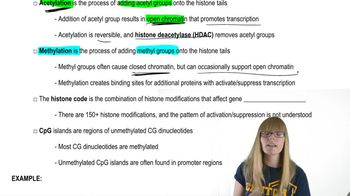Here are the essential concepts you must grasp in order to answer the question correctly.
Nucleosome Structure
A nucleosome is the fundamental unit of chromatin, consisting of a segment of DNA wrapped around a core of histone proteins. This structure resembles 'beads on a string,' where the DNA is the string and the nucleosomes are the beads. Each nucleosome typically contains about 147 base pairs of DNA and is crucial for the compaction of DNA within the nucleus.
Recommended video:
Role in Gene Regulation
Nucleosomes play a significant role in gene regulation by controlling access to DNA. The positioning and modification of nucleosomes can either expose or obscure specific gene regions, influencing transcription. This dynamic regulation is essential for cellular differentiation and response to environmental signals.
Recommended video:
Histone Modifications
Histone proteins within nucleosomes can undergo various post-translational modifications, such as acetylation, methylation, and phosphorylation. These modifications can alter the interaction between DNA and histones, affecting chromatin structure and function. Such changes are critical for processes like DNA repair, replication, and transcriptional activation or repression.
Recommended video:
Histone Protein Modifications
 Verified step by step guidance
Verified step by step guidance Verified video answer for a similar problem:
Verified video answer for a similar problem:

